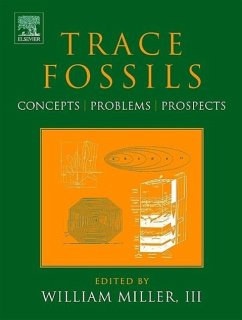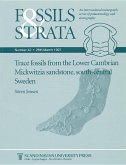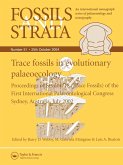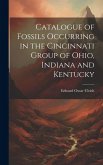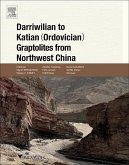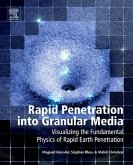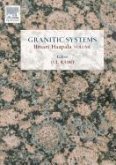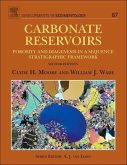Miller, III, William (ed.)Concepts, Problems, Prospects
Trace Fossils
Concepts, Problems, Prospects
Herausgeber: Miller III, William
Miller, III, William (ed.)Concepts, Problems, Prospects
Trace Fossils
Concepts, Problems, Prospects
Herausgeber: Miller III, William
- Gebundenes Buch
- Merkliste
- Auf die Merkliste
- Bewerten Bewerten
- Teilen
- Produkt teilen
- Produkterinnerung
- Produkterinnerung
This book serves as an up-to-date introduction, as well as overview to modern trace fossil research and covers nearly all of the essential aspects of modern ichnology. Divided into three section, Trace Fossils covers the historical background and concepts of ichnology, on-going research problems, and indications about the possible future growth of the discipline and potential connections to other fields. This work is intended for a broad audience of geological and biological scientists. Workers new to the field could get a sense of the main concepts of ichnology and a clear idea of how trace…mehr
Andere Kunden interessierten sich auch für
![Trace Fossils from the Lower Cambrian Mickwitzia Sandstone, South-Central Sweden Trace Fossils from the Lower Cambrian Mickwitzia Sandstone, South-Central Sweden]() S JensenTrace Fossils from the Lower Cambrian Mickwitzia Sandstone, South-Central Sweden52,99 €
S JensenTrace Fossils from the Lower Cambrian Mickwitzia Sandstone, South-Central Sweden52,99 €![Trace Fossils in Evolutionary Palaeocology Trace Fossils in Evolutionary Palaeocology]() Barry WebbyTrace Fossils in Evolutionary Palaeocology94,99 €
Barry WebbyTrace Fossils in Evolutionary Palaeocology94,99 €![Catalogue of Fossils Occurring in the Cincinnati Group of Ohio, Indiana and Kentucky Catalogue of Fossils Occurring in the Cincinnati Group of Ohio, Indiana and Kentucky]() Edward Oscar UlrichCatalogue of Fossils Occurring in the Cincinnati Group of Ohio, Indiana and Kentucky31,99 €
Edward Oscar UlrichCatalogue of Fossils Occurring in the Cincinnati Group of Ohio, Indiana and Kentucky31,99 €![Darriwilian to Katian (Ordovician) Graptolites from Northwest China Darriwilian to Katian (Ordovician) Graptolites from Northwest China]() Darriwilian to Katian (Ordovician) Graptolites from Northwest China215,99 €
Darriwilian to Katian (Ordovician) Graptolites from Northwest China215,99 €![Rapid Penetration Into Granular Media Rapid Penetration Into Granular Media]() Magued IskanderRapid Penetration Into Granular Media161,99 €
Magued IskanderRapid Penetration Into Granular Media161,99 €![Granitic Systems Granitic Systems]() O.T. Rämö (ed.)Granitic Systems151,99 €
O.T. Rämö (ed.)Granitic Systems151,99 €![Carbonate Reservoirs Carbonate Reservoirs]() Clyde H MooreCarbonate Reservoirs209,99 €
Clyde H MooreCarbonate Reservoirs209,99 €-
-
-
This book serves as an up-to-date introduction, as well as overview to modern trace fossil research and covers nearly all of the essential aspects of modern ichnology. Divided into three section, Trace Fossils covers the historical background and concepts of ichnology, on-going research problems, and indications about the possible future growth of the discipline and potential connections to other fields. This work is intended for a broad audience of geological and biological scientists. Workers new to the field could get a sense of the main concepts of ichnology and a clear idea of how trace fossil research is conducted. Scientists in related disciplines could find potential uses for trace fossils in their fields. And, established workers could use the book to check on the progress of their particular brand of ichnology. By design, there is something here for novice and veteran, insider and outsider, and for the biologically-oriented workers and for the sedimentary geologists.
Hinweis: Dieser Artikel kann nur an eine deutsche Lieferadresse ausgeliefert werden.
Hinweis: Dieser Artikel kann nur an eine deutsche Lieferadresse ausgeliefert werden.
Produktdetails
- Produktdetails
- Verlag: Elsevier Science
- Seitenzahl: 640
- Erscheinungstermin: 26. März 2007
- Englisch
- Abmessung: 280mm x 217mm x 31mm
- Gewicht: 1955g
- ISBN-13: 9780444529497
- ISBN-10: 0444529497
- Artikelnr.: 21083495
- Herstellerkennzeichnung
- Libri GmbH
- Europaallee 1
- 36244 Bad Hersfeld
- gpsr@libri.de
- Verlag: Elsevier Science
- Seitenzahl: 640
- Erscheinungstermin: 26. März 2007
- Englisch
- Abmessung: 280mm x 217mm x 31mm
- Gewicht: 1955g
- ISBN-13: 9780444529497
- ISBN-10: 0444529497
- Artikelnr.: 21083495
- Herstellerkennzeichnung
- Libri GmbH
- Europaallee 1
- 36244 Bad Hersfeld
- gpsr@libri.de
Introduction: A user's guide (W. Miller, III). List of Reviewers. Memorial
to Roland Goldring (1928-2005) (J.E. Pollard). Part 1: The Historical
Background Of Ichnology. 1. The Wadden Sea, cradle of invertebrate
ichnology (G.C. Cadée, R. Goldring). 2. The antecedents of invertebrate
ichnology in North America: the Canadian and Cincinnati schools (S.G.
Pemberton, J. A. MacEachern, M.K. Gingras). 3. Edward Hitchcock and Roland
Bird: two early titans of vertebrate ichnology in North America (S.G.
Pemberton, M.K. Gingras, J.A. MacEachern). 4. The ichnofacies paradigm: a
fifty-year retrospective (J.A. MacEachern et al). Part 2: Concepts,
Methods, Theory, And Connections To The Earth And Biologic Sciences. 5.
What's in a name? Nomenclature, systematics, ichnotaxonomy (M. Bertling).
6. Taphonomy of trace fossils (C.E. Savrda). 7. Use of trace fossils in
genetic stratigraphy (J.A. MacEachern et al) . 8. The application of trace
fossils to biostratigraphy (R.B. MacNaughton). 9. Trace fossils and marine
benthic oxygenation (C.E. Savrda). 10. Climatic control of marine trace
fossil distribution (R. Goldring, G.C. Cadée, J.E. Pollard ). 11. Climatic
controls on continental trace fossils (S.T. Hasiotis, M.J. Kraus, T.M.
Demko). 12. The trace-fossil record of vertebrates (S.T. Hasiotis et al).
13. Zoophycos and the role of type specimens in ichnotaxonomy (D. Olivero).
14. Ichnofacies, ichnocoenoses, and ichnofabric of Quaternary
shallow-marine to dunal tropical carbonates: a model and implications (H.A.
Curran). 15. Deep-sea ichnology: development of major concepts (A. Uchman).
16. Continental ichnology: fundamental processes and controls on trace
fossil distribution (S.T. Hasiotis). 17. Invertebrate ichnology of
continental freshwater environments (L.A. Buatois, M.G. Mángano). 18.
Traces of gastropod predation on molluscan prey in tropical reef
environments (S.E. Walker). 19. Early history of symbiosis in living
substrates: trace fossil evidence from the marine record (L. Tapanila, A.
A. Ekdale). 20. Macroborings and the evolution of marine bioerosion (M.A.
Wilson). 21. Microborings and microbial endoliths: geological implications
(I. Glaub et al). 22. Stromatolites: a 3.5 billion year ichnologic record
(R. S. Shapiro). 23. Trace fossils in evolutionary paleoecology (M.G.
Mángano, L.A. Buatois). Part 3: Advances, Fresh Approaches And New
Directions. 24. Importance and usefulness of trace fossils and bioturbation
in paleoceanography (L. Löwemark). 25. Theoretical and experimental
ichnology of mobile foraging (K. Koy, R.E. Plotnick). 26. Material
constraints on infaunal lifestyles: May the persistent and strong forces be
with you (P.A. Jumars et al) . 27. Complex trace fossils (W. Miller, III).
28. A constructional model for Zoophycos (D. Olivero, C. Gaillard). 29.
Arthropod tracemakers of Nereites? Neoichnological observations of juvenile
limulids and their paleoichnological applications (A.J. Martin, A.K.
Rindsberg). 30. Macaronichnus isp. associated with Piscichnus waitemata in
the Miocene of Yonaguni-jima Island, southwest Japan (N. Kotake). 31.
Meiobenthic trace fossils as keys to the taphonomic history of
shallow-marine epicontinental carbonates (D. Knaust). 32. Ichnotaxonomic
review of dendriniform borings attributed to foraminiferans: Semidendrina
igen. nov. (R.G. Bromley et al). 33. Ecological and evolutionary controls
on the composition of marine and lake ichnofacies (M.F. Miller, D.S.
White). 34. Trace fossils in an archaeological context: examples from bison
skeletons, Texas, U.S.A. (D.L. West, S.T. Hasiotis). 35. Ichnofacies of an
ancient erg: a climatically influenced trace fossil association in the
Jurassic Navajo Sandstone, southern Utah, U.S.A. (A.A. Ekdale, R.G.
Bromley,D.B. Loope). 36. Endobenthic response through mass-extinction
episodes: predictive models and observed patterns (J.R. Morrow, S.T.
Hasiotis)
to Roland Goldring (1928-2005) (J.E. Pollard). Part 1: The Historical
Background Of Ichnology. 1. The Wadden Sea, cradle of invertebrate
ichnology (G.C. Cadée, R. Goldring). 2. The antecedents of invertebrate
ichnology in North America: the Canadian and Cincinnati schools (S.G.
Pemberton, J. A. MacEachern, M.K. Gingras). 3. Edward Hitchcock and Roland
Bird: two early titans of vertebrate ichnology in North America (S.G.
Pemberton, M.K. Gingras, J.A. MacEachern). 4. The ichnofacies paradigm: a
fifty-year retrospective (J.A. MacEachern et al). Part 2: Concepts,
Methods, Theory, And Connections To The Earth And Biologic Sciences. 5.
What's in a name? Nomenclature, systematics, ichnotaxonomy (M. Bertling).
6. Taphonomy of trace fossils (C.E. Savrda). 7. Use of trace fossils in
genetic stratigraphy (J.A. MacEachern et al) . 8. The application of trace
fossils to biostratigraphy (R.B. MacNaughton). 9. Trace fossils and marine
benthic oxygenation (C.E. Savrda). 10. Climatic control of marine trace
fossil distribution (R. Goldring, G.C. Cadée, J.E. Pollard ). 11. Climatic
controls on continental trace fossils (S.T. Hasiotis, M.J. Kraus, T.M.
Demko). 12. The trace-fossil record of vertebrates (S.T. Hasiotis et al).
13. Zoophycos and the role of type specimens in ichnotaxonomy (D. Olivero).
14. Ichnofacies, ichnocoenoses, and ichnofabric of Quaternary
shallow-marine to dunal tropical carbonates: a model and implications (H.A.
Curran). 15. Deep-sea ichnology: development of major concepts (A. Uchman).
16. Continental ichnology: fundamental processes and controls on trace
fossil distribution (S.T. Hasiotis). 17. Invertebrate ichnology of
continental freshwater environments (L.A. Buatois, M.G. Mángano). 18.
Traces of gastropod predation on molluscan prey in tropical reef
environments (S.E. Walker). 19. Early history of symbiosis in living
substrates: trace fossil evidence from the marine record (L. Tapanila, A.
A. Ekdale). 20. Macroborings and the evolution of marine bioerosion (M.A.
Wilson). 21. Microborings and microbial endoliths: geological implications
(I. Glaub et al). 22. Stromatolites: a 3.5 billion year ichnologic record
(R. S. Shapiro). 23. Trace fossils in evolutionary paleoecology (M.G.
Mángano, L.A. Buatois). Part 3: Advances, Fresh Approaches And New
Directions. 24. Importance and usefulness of trace fossils and bioturbation
in paleoceanography (L. Löwemark). 25. Theoretical and experimental
ichnology of mobile foraging (K. Koy, R.E. Plotnick). 26. Material
constraints on infaunal lifestyles: May the persistent and strong forces be
with you (P.A. Jumars et al) . 27. Complex trace fossils (W. Miller, III).
28. A constructional model for Zoophycos (D. Olivero, C. Gaillard). 29.
Arthropod tracemakers of Nereites? Neoichnological observations of juvenile
limulids and their paleoichnological applications (A.J. Martin, A.K.
Rindsberg). 30. Macaronichnus isp. associated with Piscichnus waitemata in
the Miocene of Yonaguni-jima Island, southwest Japan (N. Kotake). 31.
Meiobenthic trace fossils as keys to the taphonomic history of
shallow-marine epicontinental carbonates (D. Knaust). 32. Ichnotaxonomic
review of dendriniform borings attributed to foraminiferans: Semidendrina
igen. nov. (R.G. Bromley et al). 33. Ecological and evolutionary controls
on the composition of marine and lake ichnofacies (M.F. Miller, D.S.
White). 34. Trace fossils in an archaeological context: examples from bison
skeletons, Texas, U.S.A. (D.L. West, S.T. Hasiotis). 35. Ichnofacies of an
ancient erg: a climatically influenced trace fossil association in the
Jurassic Navajo Sandstone, southern Utah, U.S.A. (A.A. Ekdale, R.G.
Bromley,D.B. Loope). 36. Endobenthic response through mass-extinction
episodes: predictive models and observed patterns (J.R. Morrow, S.T.
Hasiotis)
Introduction: A user's guide (W. Miller, III). List of Reviewers. Memorial
to Roland Goldring (1928-2005) (J.E. Pollard). Part 1: The Historical
Background Of Ichnology. 1. The Wadden Sea, cradle of invertebrate
ichnology (G.C. Cadée, R. Goldring). 2. The antecedents of invertebrate
ichnology in North America: the Canadian and Cincinnati schools (S.G.
Pemberton, J. A. MacEachern, M.K. Gingras). 3. Edward Hitchcock and Roland
Bird: two early titans of vertebrate ichnology in North America (S.G.
Pemberton, M.K. Gingras, J.A. MacEachern). 4. The ichnofacies paradigm: a
fifty-year retrospective (J.A. MacEachern et al). Part 2: Concepts,
Methods, Theory, And Connections To The Earth And Biologic Sciences. 5.
What's in a name? Nomenclature, systematics, ichnotaxonomy (M. Bertling).
6. Taphonomy of trace fossils (C.E. Savrda). 7. Use of trace fossils in
genetic stratigraphy (J.A. MacEachern et al) . 8. The application of trace
fossils to biostratigraphy (R.B. MacNaughton). 9. Trace fossils and marine
benthic oxygenation (C.E. Savrda). 10. Climatic control of marine trace
fossil distribution (R. Goldring, G.C. Cadée, J.E. Pollard ). 11. Climatic
controls on continental trace fossils (S.T. Hasiotis, M.J. Kraus, T.M.
Demko). 12. The trace-fossil record of vertebrates (S.T. Hasiotis et al).
13. Zoophycos and the role of type specimens in ichnotaxonomy (D. Olivero).
14. Ichnofacies, ichnocoenoses, and ichnofabric of Quaternary
shallow-marine to dunal tropical carbonates: a model and implications (H.A.
Curran). 15. Deep-sea ichnology: development of major concepts (A. Uchman).
16. Continental ichnology: fundamental processes and controls on trace
fossil distribution (S.T. Hasiotis). 17. Invertebrate ichnology of
continental freshwater environments (L.A. Buatois, M.G. Mángano). 18.
Traces of gastropod predation on molluscan prey in tropical reef
environments (S.E. Walker). 19. Early history of symbiosis in living
substrates: trace fossil evidence from the marine record (L. Tapanila, A.
A. Ekdale). 20. Macroborings and the evolution of marine bioerosion (M.A.
Wilson). 21. Microborings and microbial endoliths: geological implications
(I. Glaub et al). 22. Stromatolites: a 3.5 billion year ichnologic record
(R. S. Shapiro). 23. Trace fossils in evolutionary paleoecology (M.G.
Mángano, L.A. Buatois). Part 3: Advances, Fresh Approaches And New
Directions. 24. Importance and usefulness of trace fossils and bioturbation
in paleoceanography (L. Löwemark). 25. Theoretical and experimental
ichnology of mobile foraging (K. Koy, R.E. Plotnick). 26. Material
constraints on infaunal lifestyles: May the persistent and strong forces be
with you (P.A. Jumars et al) . 27. Complex trace fossils (W. Miller, III).
28. A constructional model for Zoophycos (D. Olivero, C. Gaillard). 29.
Arthropod tracemakers of Nereites? Neoichnological observations of juvenile
limulids and their paleoichnological applications (A.J. Martin, A.K.
Rindsberg). 30. Macaronichnus isp. associated with Piscichnus waitemata in
the Miocene of Yonaguni-jima Island, southwest Japan (N. Kotake). 31.
Meiobenthic trace fossils as keys to the taphonomic history of
shallow-marine epicontinental carbonates (D. Knaust). 32. Ichnotaxonomic
review of dendriniform borings attributed to foraminiferans: Semidendrina
igen. nov. (R.G. Bromley et al). 33. Ecological and evolutionary controls
on the composition of marine and lake ichnofacies (M.F. Miller, D.S.
White). 34. Trace fossils in an archaeological context: examples from bison
skeletons, Texas, U.S.A. (D.L. West, S.T. Hasiotis). 35. Ichnofacies of an
ancient erg: a climatically influenced trace fossil association in the
Jurassic Navajo Sandstone, southern Utah, U.S.A. (A.A. Ekdale, R.G.
Bromley,D.B. Loope). 36. Endobenthic response through mass-extinction
episodes: predictive models and observed patterns (J.R. Morrow, S.T.
Hasiotis)
to Roland Goldring (1928-2005) (J.E. Pollard). Part 1: The Historical
Background Of Ichnology. 1. The Wadden Sea, cradle of invertebrate
ichnology (G.C. Cadée, R. Goldring). 2. The antecedents of invertebrate
ichnology in North America: the Canadian and Cincinnati schools (S.G.
Pemberton, J. A. MacEachern, M.K. Gingras). 3. Edward Hitchcock and Roland
Bird: two early titans of vertebrate ichnology in North America (S.G.
Pemberton, M.K. Gingras, J.A. MacEachern). 4. The ichnofacies paradigm: a
fifty-year retrospective (J.A. MacEachern et al). Part 2: Concepts,
Methods, Theory, And Connections To The Earth And Biologic Sciences. 5.
What's in a name? Nomenclature, systematics, ichnotaxonomy (M. Bertling).
6. Taphonomy of trace fossils (C.E. Savrda). 7. Use of trace fossils in
genetic stratigraphy (J.A. MacEachern et al) . 8. The application of trace
fossils to biostratigraphy (R.B. MacNaughton). 9. Trace fossils and marine
benthic oxygenation (C.E. Savrda). 10. Climatic control of marine trace
fossil distribution (R. Goldring, G.C. Cadée, J.E. Pollard ). 11. Climatic
controls on continental trace fossils (S.T. Hasiotis, M.J. Kraus, T.M.
Demko). 12. The trace-fossil record of vertebrates (S.T. Hasiotis et al).
13. Zoophycos and the role of type specimens in ichnotaxonomy (D. Olivero).
14. Ichnofacies, ichnocoenoses, and ichnofabric of Quaternary
shallow-marine to dunal tropical carbonates: a model and implications (H.A.
Curran). 15. Deep-sea ichnology: development of major concepts (A. Uchman).
16. Continental ichnology: fundamental processes and controls on trace
fossil distribution (S.T. Hasiotis). 17. Invertebrate ichnology of
continental freshwater environments (L.A. Buatois, M.G. Mángano). 18.
Traces of gastropod predation on molluscan prey in tropical reef
environments (S.E. Walker). 19. Early history of symbiosis in living
substrates: trace fossil evidence from the marine record (L. Tapanila, A.
A. Ekdale). 20. Macroborings and the evolution of marine bioerosion (M.A.
Wilson). 21. Microborings and microbial endoliths: geological implications
(I. Glaub et al). 22. Stromatolites: a 3.5 billion year ichnologic record
(R. S. Shapiro). 23. Trace fossils in evolutionary paleoecology (M.G.
Mángano, L.A. Buatois). Part 3: Advances, Fresh Approaches And New
Directions. 24. Importance and usefulness of trace fossils and bioturbation
in paleoceanography (L. Löwemark). 25. Theoretical and experimental
ichnology of mobile foraging (K. Koy, R.E. Plotnick). 26. Material
constraints on infaunal lifestyles: May the persistent and strong forces be
with you (P.A. Jumars et al) . 27. Complex trace fossils (W. Miller, III).
28. A constructional model for Zoophycos (D. Olivero, C. Gaillard). 29.
Arthropod tracemakers of Nereites? Neoichnological observations of juvenile
limulids and their paleoichnological applications (A.J. Martin, A.K.
Rindsberg). 30. Macaronichnus isp. associated with Piscichnus waitemata in
the Miocene of Yonaguni-jima Island, southwest Japan (N. Kotake). 31.
Meiobenthic trace fossils as keys to the taphonomic history of
shallow-marine epicontinental carbonates (D. Knaust). 32. Ichnotaxonomic
review of dendriniform borings attributed to foraminiferans: Semidendrina
igen. nov. (R.G. Bromley et al). 33. Ecological and evolutionary controls
on the composition of marine and lake ichnofacies (M.F. Miller, D.S.
White). 34. Trace fossils in an archaeological context: examples from bison
skeletons, Texas, U.S.A. (D.L. West, S.T. Hasiotis). 35. Ichnofacies of an
ancient erg: a climatically influenced trace fossil association in the
Jurassic Navajo Sandstone, southern Utah, U.S.A. (A.A. Ekdale, R.G.
Bromley,D.B. Loope). 36. Endobenthic response through mass-extinction
episodes: predictive models and observed patterns (J.R. Morrow, S.T.
Hasiotis)

